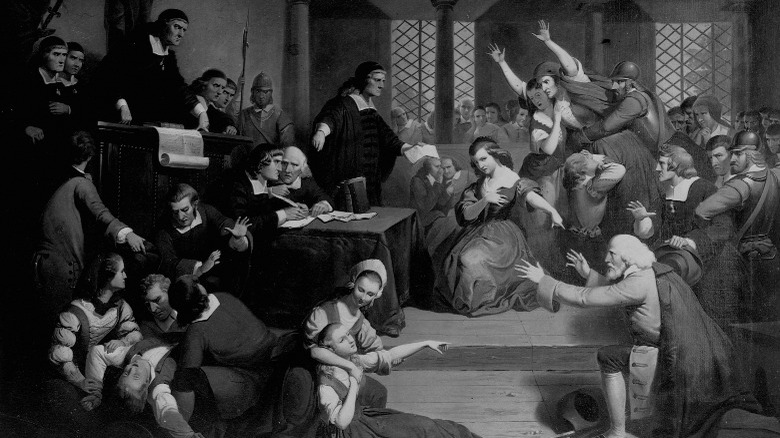Spoiled Bread May Have Caused The Salem Witch Trials
There's a seemingly endless debate about the causes and reasons behind the infamous American mass hysteria event known as the Salem witch trials. The violent spree of deadly accusations has become so ingrained in American history and culture that stories about the period seem to have taken on a legendary and mythical quality of their own. Theories as to why neighbors started accusing each other of using dark magical powers include social ills, religious fanaticism, and economic change, but perhaps the strangest reason for this superstitious outburst is a food-borne illness called ergotism, which might have been caused by moldy rye bread.
Rensselaer Polytechnic Institute professor Linnda R. Caporael first proposed this theory in their 1976 paper published in Science, with the title "Ergotism: The Satan Loosed in Salem?". In it, Caporael chronologically and geographically connects Salem's rye fields with the witchcraft allegations. In a compelling bit of detective work, they suggest that there was a strong correlation between the cycle of the rye-growing season and supernatural-sounding testimonies. The concentrated levels of rye in and around Salem, as well as a particularly warm wet farming season, created a perfect storm of ergot poisoning when hapless villagers, who thought the fungal growths were due to sun exposure, ingested their supply of bread for the season.
The ins and outs of ergotism
The ergot fungus is most known for harboring the molecule known as lysergic acid, a key ingredient in the synthesis of the psychedelic substance known as LSD (lysergic acid diethylamide). On a basic level, this means that those who claimed they were suffering from witchcraft spells were quite literally tripping out, although the specifics are more complicated than that. Ergot poisoning is an unpleasant experience that includes painful physical symptoms alongside unsettling psychological effects.
Symptoms include muscle spasms, convulsions, prickling sensations on the skin, nausea, vomiting, and hallucinations. All of these could be found in the testimonies of those who claimed they fell under the influence of a witch's curse. As Caporael points out, "victims" of witchcraft complained of seizure-like fits in which they writhed on the floor while shadowy figures watched. Others spoke of biting, pinching, and, in one case, a "very hard blow" to the chest that knocked a man off his horse. In one especially creepy incident, a witness claimed he was strangled by a witch who brought a clawed half-man, half-monkey creature through his window. Strikingly, the last trial before the hysteria died out occurred in May 1693, right when the season's rye supply would have reached its end.
Ergo, perhaps not ergot
In response to Caporael, Nicholas P. Spanos and Jack Gottlieb of the University of Massachusetts at Amherst wrote a paper in 1983 — published in the Journal of the History of the Behavioral Sciences — attempting to disprove the ergotism poisoning theory. They argue that symptoms range further than the type of activity reported by those in Salem and that Caporael may have even exaggerated her historical research. According to Spanos and Gottlieb, people under the influence of ergot poisoning can potentially have discolored skin, a visible but unreported element. In addition, they point out that the cases of gastrointestinal symptoms among the afflicted are highly limited, and that Caporael's claims of nausea are actually false. The types of hallucinations attributed to LSD and ergot poisoning are also almost never as vivid as the ones described by witnesses, usually amounting to distortions in texture and color as opposed to spectral-like entities.
Perhaps most importantly, witnesses complaining of witchcraft experienced their symptoms on a temporary, on-and-off basis, whereas ergot poisoning is more of a constant and sometimes permanent ordeal. Those who claimed they were cursed by a witch conveniently reported their symptoms in response to external social stimuli, while they remained healthy and active during court trials. That means that, though it's more depressing than chalking up selfish, violent behavior to psychedelic drugs, the Salem witch trials were probably more the result of an unfortunate collision between Puritan fanaticism and the rising economic mobility of women. In short, the event was more bigotry than bread.



